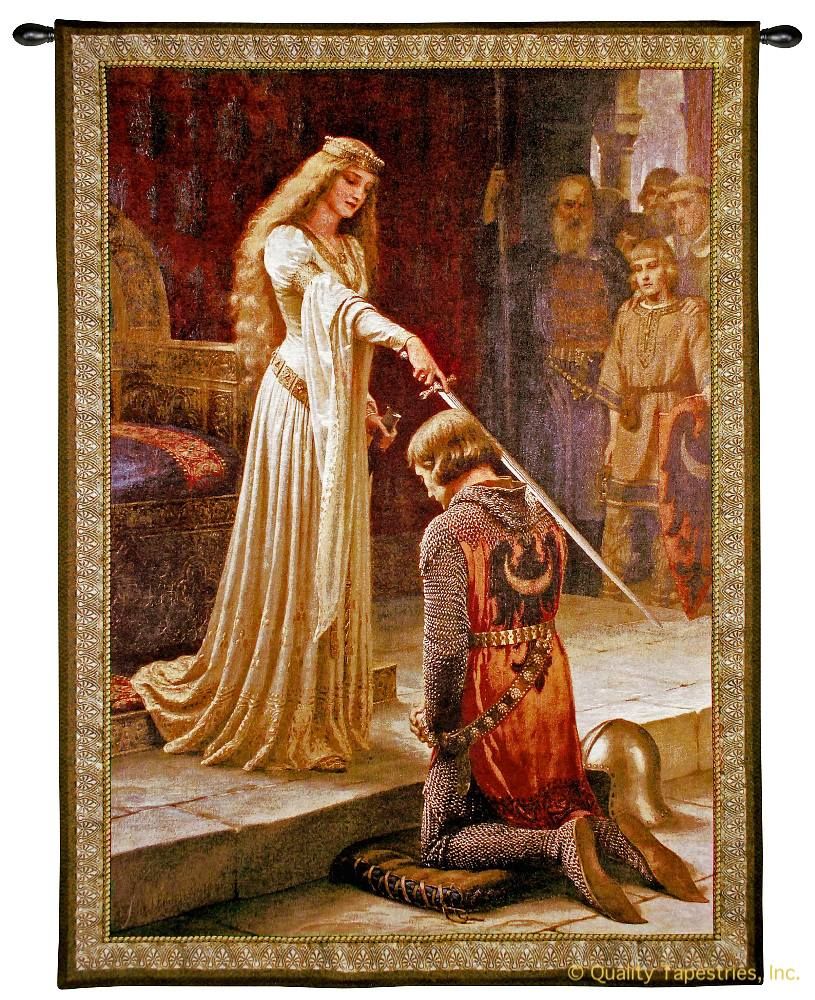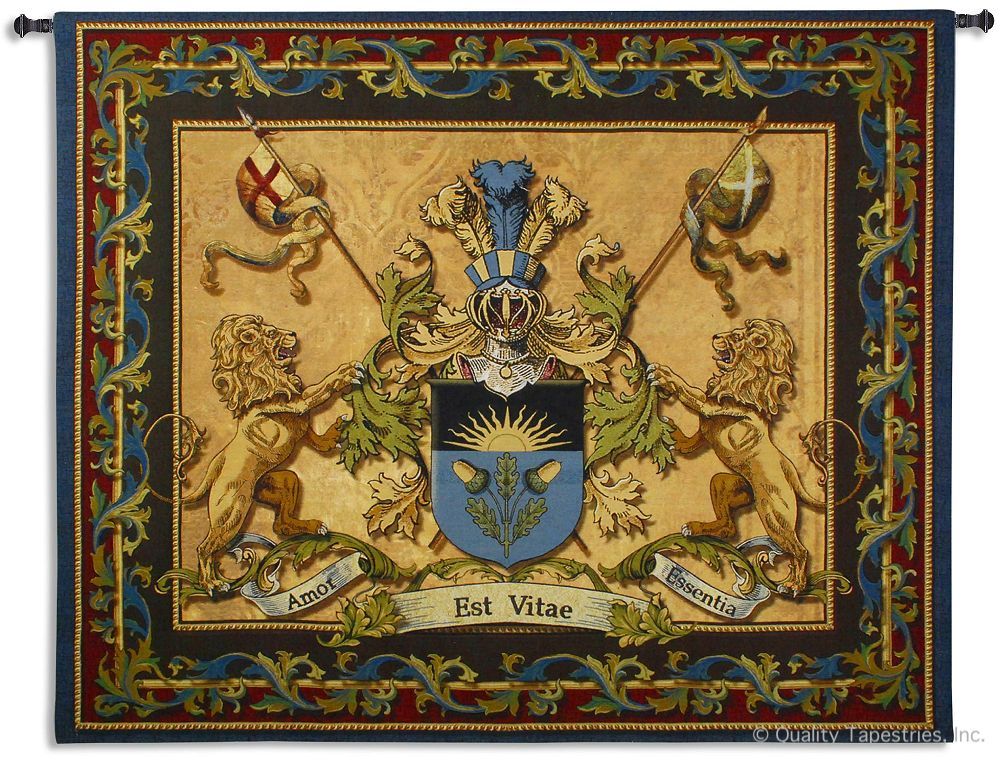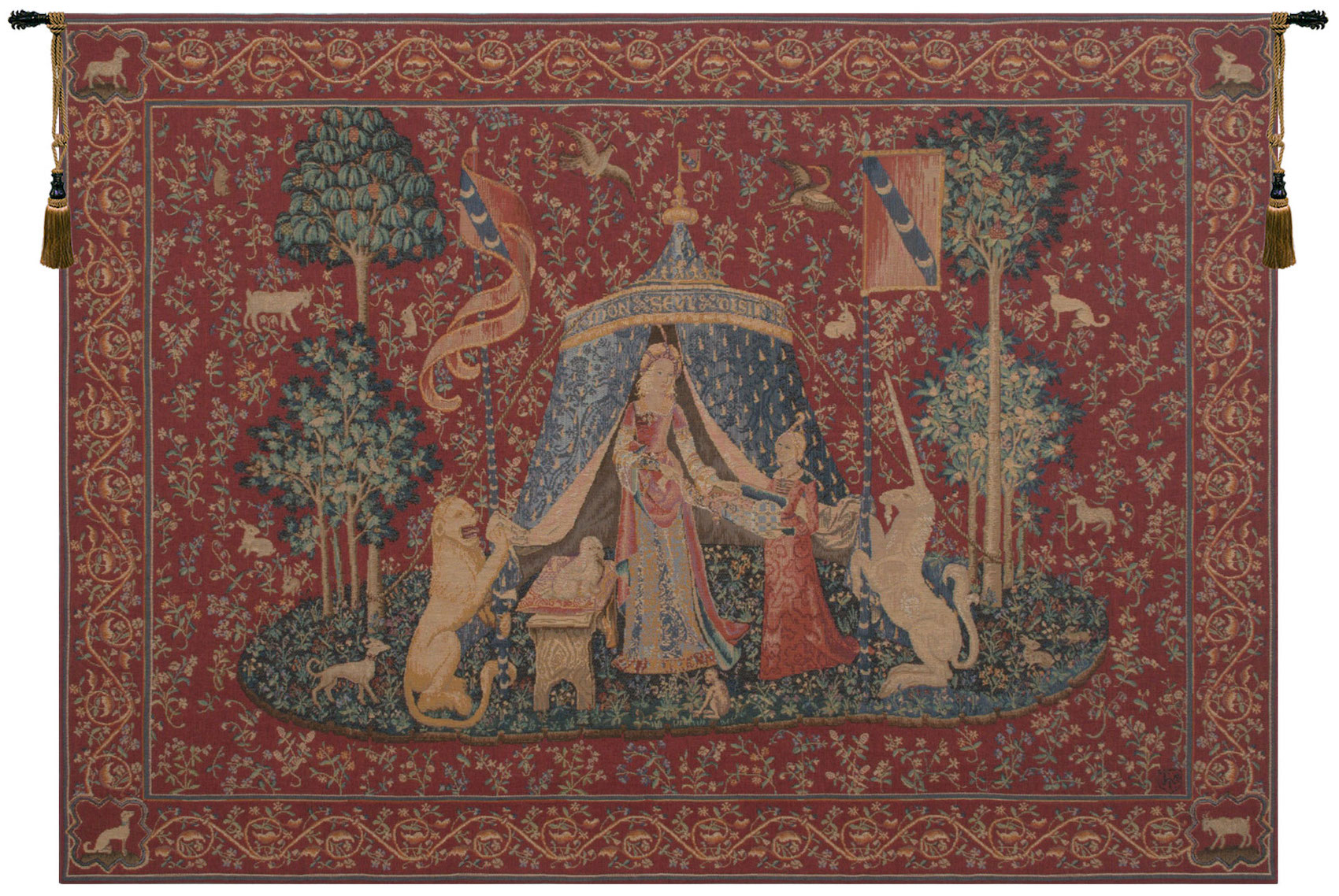Wall Tapestries
×
STYLE: Medieval & Old World
Products 1-42 of 264
Show

From a set of tapestries called the Royale Residences made at the Gobelins for King Louis XIV towards the end of 17th century. They were designed by Charles Le Brun a prominent painter and designer of the late 17th century. Le Bruns work was admired by many, especially King Louis XIV, who eventually made him the First Painter to the King. This jacquard woven tapestry depicts a castle surrounded by green foliage contrasted by a foreground of a columned terrace with a red drape, pillowed...

Based on a classic painting by Edmund Blair Leighton entitled 'The Accolade'. It is one of his many paintings depicting the subject of chivalry and has been considered as one of his best-known works. This scene depicts an accolade ceremony where one is bestowed the honor of knighthood. The brave knight dressed in a coat of chain mail armor kneels before the beautiful queen and is sworn in with the edge of a sword. An audience watches on to the right of the scene as witnesses to the ceremony.

A scene from Claude Monet's gardens at Giverny. Monet lived and painted in Giverny from 1883 until his death in 1926. He noticed the village of Giverny while looking out of a train window and was determined to move there, he eventually purchased a house and property and began a great landscaping project which included lily ponds that would become the subjects of his best-known works. Monet's garden is much today as it was when he painted his famous lake Giverny, as reflected in this tapestry.

A tapestry of the classic painting by Edmund Blair Leighton Entitled 'God Speed' painted in the 1900s. Featuring a beautiful red-haired woman wishing her beloved knight in armor a farewell and safe return as he prepares to ride into battle on his white steed. She ties a red sash around the knight's arm, which he is meant to return. This was typical in medieval times and was meant to assure that the knight returns alive and well. God Speed was the first of several paintings by Leighton on the...

This beautiful wall tapestry translates Austrian symbolist painter Gustav Klimt's most enduring masterpiece, The Kiss, into tapestry form. This tapestry was painted during the height of Klimt's Golden Period, it features two lovers in a sweet embrace, both wearing embellished robes featuring Art Nouveau style. Beautiful, vibrant, and romantic, the unique geometric shapes of this piece seem to have a life of their own. Bright yellow hues lend the piece a remarkable vivacity while the golden...

This wall tapestry is inspired from the Tentures des Maisons Royales, a set of 12 tapestries woven at the Gobelins Factory in Paris towards the end of the 17th century for King Louis XIV of France. Each of the original 12 tapestries depicted a different castle at each month of the year. Here is a typical 17th century castle in an August landscape. This tapestry is brand new.This tapestry is also available in a square size of 58"W x 58"H.Note: The largest available size of 110"W x 58"H is a...

An ornate tapestry featuring a design by artist Bob Bergin. This beautiful regal wall hanging displays a heraldic crest and the words love, strength, and, courage in Latin. This wall hanging is woven in rich jewel tones and is completed with an intricate border.

This is a brand new reproduction tapestry of a vintage piece. The original tapestry was woven in Flanders, Belgium, in the late 15th century and now hangs in the Cluny museum in Paris. The scene depicts the bustle of harvest time, exemplifying grape gathering and the wine press. It shows the two methods of pressing used in medieval times: pressing grapes with the feet, and pressing with the screw, to extract the juice, and then collected in wooden barrels. This marvelous antique replica is...

A Mon Seul Desir I is one of the famous six tapestries in the The Lady and the Unicorn series residing in the Cluny museum. Woven in about 1511 they feature the arms of Jean le Viste. Each represents one of the senses except for the final A Mon Seul Desir. Also known as My Sole Desire, this piece is woven in the jaquard style and depicts a young woman of high society with her servant surrounded by a unicorn and a lion on a red background with many flowers and animals.

This map of the world was created by the Flemish map engraver Jan Baptist Vrients in 1596. It features an ornate double hemisphere and is the second earliest printed map of the world to include allegorical vignettes around the two hemispheres. The continents of Europe, Asia, Africa and America are represented in the four corners as are animals indigenous to each area.

The original Bayeux Tapestry was a series of embroidered linen strips that depicted the pictorial history of the invasion of England by William of Normandy. It is believed that it was commissioned by Bishop Odo, the half-brother of William, and it was made in England and then displayed In Bayeux Cathedral, hence the name Bayeaux. That original Bayeux Tapestry is nearly 1,000 years old and was 230 feet long! This one here is a brand new replica at a very affordable cost.

Giverny Pond is a jacquard woven tapestry depicting a beautiful landscape with a pond, weeping willow trees, various flora, and a classical bridge crossing. A gorgeous and romantic tapestry.

Inspired by tapestries woven at the beginning of the 18th century at the Royal Manufacture of Beauvais, just north of Paris, France. Featuring a verdure landscape alive with color and life of finely detailed flowers in the foreground and a stately manor and estate in the background, taking the viewer to an enchanting place. Tapestries with medallions were generally used to decorate royal or bourgeois mansions.

Enjoy this brand new tapestry reproduction from the famous Lady and the Unicorn tapestry series. In this scene, the lady stands in front of a tent, across the top of which is written "À Mon Seul Désir", an obscure motto, variously interpretable as "my one/sole desire", "according to my desire alone"; "by my will alone", "love desires only beauty of soul", "to calm passion". Her maidservant stands to the right, holding...

The Unicorn in Captivity is the last in a series of seven in the collection of medieval art housed at The Cloisters. Together they illustrate the unicorn myth, which was rich with symbolism. No hunter could capture the unicorn without the aid of a maiden, to whom the beast would willingly surrender. The background color of this tapestry is a deep green. This item is also available without the border as item W-6863.

Built in 1513 during the Renaissance. Diane de Poitiers and Catherine de Medicis lived in this magnificent castle.

This modern wall tapestry brings new life to The Hunt of the Unicorn series which originally consisted of seven pieces woven in wool, silk, and gilt. Originally woven in the Southern Netherlands between 1495 and 1505, it was concluded that they were commissioned by Anne of Brittany, to celebrate her marriage to Louis XII, King of France, on December 6, 1491. This was determined by the A and reversed E featured throughout the series which were interpreted as the first and the last letters of...

This tapestry tells the story of collecting grapes then pressing them to make wine. The original tapestry was woven in Tournai in the 15th century. This is a remarkable representation of the grape gathering and the wine press on a 'Mille Fleurs' background. The original is exposed at the Cluny Museum in Paris, France.

In this famous tapestry known as The Unicorn in Captivity, the unicorn is shown alive again and happy, chained to a pomegranate tree surrounded by a fence in a field of flowers. Originally woven in the Southern Netherlands between 1495 and 1505. This is a brand new reproduction tapestry.

A reproduction of a painting by Gustav Klimt (1862-1918). Klimt’s eclectic range of influences included Egyptian, Classical Greek, Byzantine and Medieval styles. A forerunner of Modernism and the Art Deco movements, Klimt’s huge creative influence still resonates in modern art, decorations and jewelry.

Medieval Concert Belgian tapestry shows a scene of music and song, from the medieval period. Filled with medieval style, this work shows an organist, a lutist, a violinist and singers enjoying the past time of music. Medieval art was filled with subjects of everyday life including their past times. Their garments are elaborate and richly decorated, a sign of their nobility. A mille fleur or thousand flower background so typical of art in the middle ages is seen here.

This tapestry is an extract from a famous late 15th-century Flemish tapestry now at the Cluny Museum in Paris. It evokes scenes of the grape harvest from the crop cluster to the barrel of wine. Two methods of expelling wine are displayed here, one by stomping on the grapes, and the other by using a press. The scene all unfolds on a mille fleur background.

The romantic appeal of Sir Francis Dicksee's medieval style earned him great success and popularity. This creation is his interpretation of John Keats poem, La Belle Dame sans Merci.

A brand new tapestry reproduction, woven in France! The original of this wall tapestry, woven in Beauvais in the middle of the 19th century, was inspired by the work of Jean-Baptiste Monoyera specialist of still life paintings in the 17th century. The original is on exhibition at Musuem d'Orsay in Paris.

Woven circa 1520 by Pieter van Aeist, a Flemish master weaver in Brussels, most likely for the French market where mille fleurs designs were popular. This is a brand new wall tapestry reproduction, woven after the original.

This is a gorgeous tapestry depicting an 18th century scene of Lake Como in Italy. The gardens and terrace are those of Villa de Este estate. Add a unique touch to your space with this lovely piece!

Enjoy this brand new tapestry reproduction from the famous Lady and the Unicorn tapestry series. In this scene, the lady is seated, holding a mirror up in her hand. The unicorn kneels on the ground, with his front legs in the lady's lap, from which he gazes at his reflection in the mirror. The lion holds up a pennant.

This is a brand new tapestry reproduction, woven after a large tapestry drawn by William Morris and Edward Burne-Jones and then woven in the workshops of Morris and Company (1890-1895). Considered as a major piece of the decorative art of the Victorian time, this tapestry depicts the Quest for the Holy Grail. The Knights of the Round Table make their farewells to the ladies of Camelot.

Part of the William Morris collection. A beautiful brand new wall tapestry reproduction.

Originally woven in Brussels in the mid 16th century. A lovely wooded stream teeming with animals and foliage.

This Belgian tapestry is the seventh tapestry in the tapestries of the unicorn series. The Unicorn in Captivity is the last in a series of seven in the collection of medieval art housed at The Cloisters. Together they illustrate the unicorn myth, which was rich with symbolism. No hunter could capture the unicorn without the aid of a maiden, to whom the beast would willingly surrender. The background color of this tapestry is a deep green.

Enjoy this brand new tapestry reproduction from the famous Lady and the Unicorn tapestry series. In this scene, the lady is taking sweets from a dish held by a maidservant. Her eyes are on a parakeet on her upheld left hand. The lion and the unicorn are both standing on their hind legs reaching up to pennants that frame the lady on either side. The monkey is at her feet, eating one of the sweetmeats.

This is one of the six tapestries in the Lady and the Unicorn series. This tapestry represents the sense of smell. The lady stands, making a wreath of flowers. Her maidservant holds a basket of flowers within her easy reach. Again, the lion and unicorn frame the lady while holding on to the pennants. The monkey has stolen a flower which he is smelling, providing the key to the allegory.

Maximilian I the emperor of the Burgundian Netherlands from 1477 was a passionate lover of tapestries. The hounds are brought from the imperial hunting lodge.

This tapestry depicts a woodpecker against an ornate backdrop and was designed by Morris & Co in 1877. Most of the company's production was a collaborative effort involving several artists, but Woodpecker is unusual in that it was one of the very few tapestries designed by William Morris in its entirety. It shows a woodpecker sitting in the branch of a fruit tree and features Morris' distinctive ornate background of leaves and his legendary attention to detail. The wording on the top and...

This Belgian tapestry is a replica of one of the six tapestries in the Lady and the Unicorn series. This tapestry represents the sense of sight. The lady is seated, holding a mirror up in her right hand. The unicorn kneels on the ground, with his front le

The builder of fairy-tale castles and palaces filled with gold, love of opera and rider of mechanical swans, was King Ludwig II of Bavaria (1845-1886).

This is a beautiful tapestry reproduction from the original artwork of Charles Le Brun (1619-1690). The King's pipers and drummers are the subject of this exquisitely detailed tapestry. In this scene we see a man, woman, two children and their dog interacting with the musicians. The landscape is beautiful and idyllic with intricate detail in the foliage of the trees, plants and landscape of the countryside. A river behind them produces a luscious backdrop to the scene. The work of Le Brun is...

This tapestry depicts a woodpecker against an ornate backdrop and was designed by Morris & Co in 1877. Most of the company's production was a collaborative effort involving several artists, but Woodpecker is unusual in that it was one of the very few tapestries designed by William Morris in its entirety. It shows a woodpecker sitting in the branch of a fruit tree and features Morris' distinctive ornate background of leaves and his legendary attention to detail. The wording on the top and...

Illustrating Lord Alfred Tennyson's 1883 poem, Lady of Shalott, John William Waterhouse's painting eloquently captures the Lady's wistful, doomed quality as she embarks on her final voyage to Camelot.

A reproduction of a painting by Gustav Klimt (1862-1918). Add a unique touch to your space with this European woven wall tapestry!

An amazing old world French medieval style tapestry. This wall tapestry is woven in North Carolina, USA and hand finished by skilled artisans.